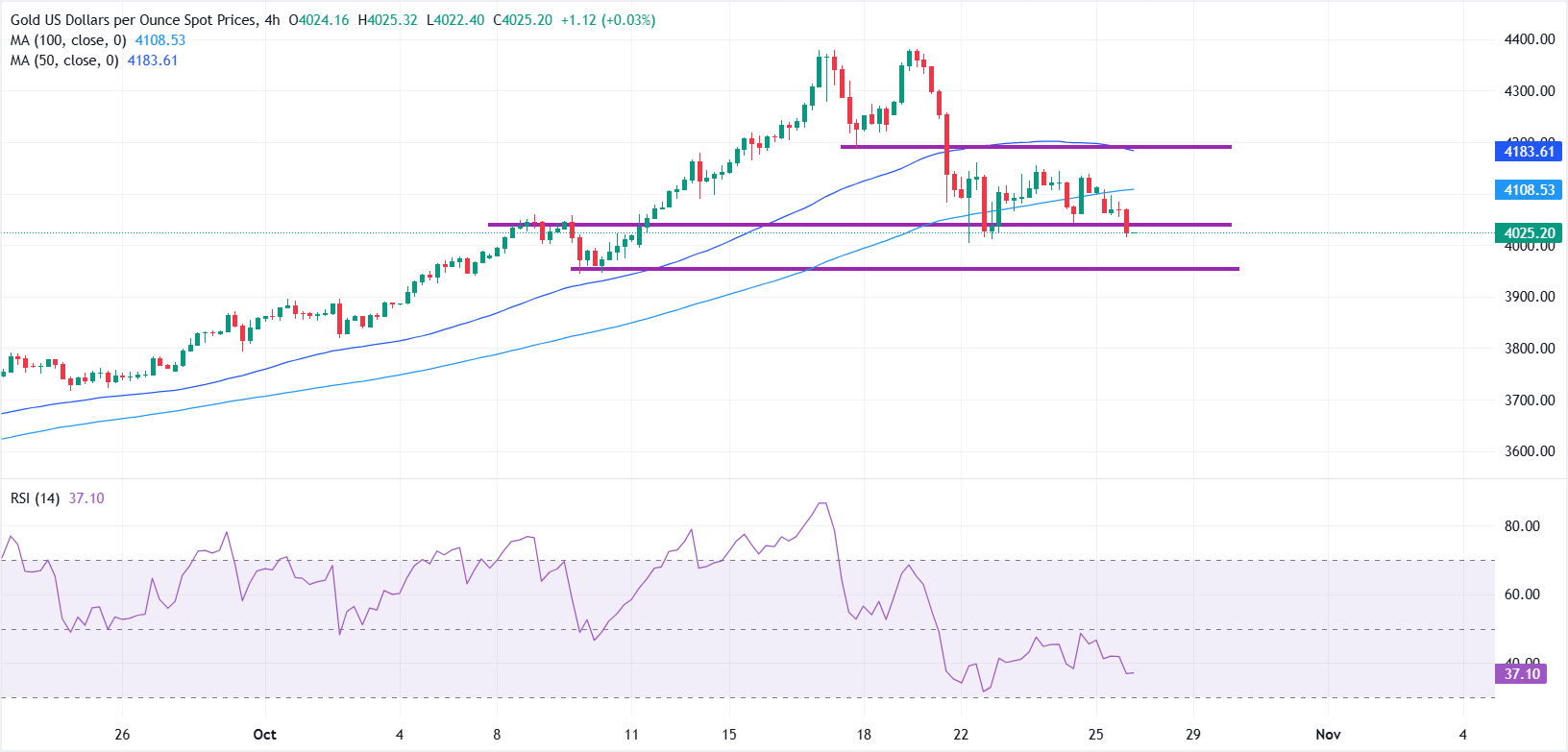Created
: 2025.10.27














![]() 2025.10.27 21:03
2025.10.27 21:03
Gold (XAU/USD) kicks off the week with a negative tone, as improved risk appetite curbed demand for safe-haven assets. At the time of writing, XAU/USD is trading around $4,025, down over 2.0%, extending its retreat from last week's record high of $4,381 after a wave of profit-taking spurred by progress in trade talks.
Positive trade headlines have boosted market sentiment, with equities extending gains across the globe. Over the weekend, US and Chinese negotiators reportedly reached a preliminary trade framework, setting the stage for further progress ahead of President Donald Trump's meeting with his Chinese counterpart, Xi Jinping, on Thursday. Trump also signed separate trade framework pacts with Malaysia, Thailand, Vietnam, and Cambodia.
Although markets are in a buoyant mood, a degree of caution prevails as focus shifts squarely to monetary policy. Investors face an event-packed week with key central-bank meetings from the Federal Reserve (Fed), Bank of Canada (BoC), Bank of Japan (BoJ) and the European Central Bank (ECB).
While easing trade tensions has provided some short-term relief, Gold's downside appears limited as traders remain wary of President Trump's unpredictable trade stance. Meanwhile, the prolonged US government shutdown and lingering geopolitical and economic uncertainties continue to keep investors cautious.

Gold bears remain in control as prices struggle to hold above the $4,000 psychological mark. The metal continues to trade below the 50- and 100-period Simple Moving Averages (SMAs) near $4,187 and $4,107, reflecting a bearish short-term bias.
Immediate support sits near the $4,000 mark, where bulls may attempt to defend the level, though momentum remains fragile. A decisive break below $4,000 would likely embolden bears, paving the way for further downside toward $3,950 and even $3,900.
On the upside, immediate resistance is seen in the $4,100-$4,150 zone, where sellers have repeatedly capped recoveries. A stronger barrier sits near $4,200, the previous breakout region where bulls are likely to face renewed selling pressure.
The Relative Strength Index (RSI) hovers around 37, staying close to the oversold region and signaling that bearish momentum remains in play.
Gold has played a key role in human's history as it has been widely used as a store of value and medium of exchange. Currently, apart from its shine and usage for jewelry, the precious metal is widely seen as a safe-haven asset, meaning that it is considered a good investment during turbulent times. Gold is also widely seen as a hedge against inflation and against depreciating currencies as it doesn't rely on any specific issuer or government.
Central banks are the biggest Gold holders. In their aim to support their currencies in turbulent times, central banks tend to diversify their reserves and buy Gold to improve the perceived strength of the economy and the currency. High Gold reserves can be a source of trust for a country's solvency. Central banks added 1,136 tonnes of Gold worth around $70 billion to their reserves in 2022, according to data from the World Gold Council. This is the highest yearly purchase since records began. Central banks from emerging economies such as China, India and Turkey are quickly increasing their Gold reserves.
Gold has an inverse correlation with the US Dollar and US Treasuries, which are both major reserve and safe-haven assets. When the Dollar depreciates, Gold tends to rise, enabling investors and central banks to diversify their assets in turbulent times. Gold is also inversely correlated with risk assets. A rally in the stock market tends to weaken Gold price, while sell-offs in riskier markets tend to favor the precious metal.
The price can move due to a wide range of factors. Geopolitical instability or fears of a deep recession can quickly make Gold price escalate due to its safe-haven status. As a yield-less asset, Gold tends to rise with lower interest rates, while higher cost of money usually weighs down on the yellow metal. Still, most moves depend on how the US Dollar (USD) behaves as the asset is priced in dollars (XAU/USD). A strong Dollar tends to keep the price of Gold controlled, whereas a weaker Dollar is likely to push Gold prices up.
![]()
Created
: 2025.10.27
![]()
Last updated
: 2025.10.27

FXStreet is a forex information website, delivering market analysis and news articles 24/7.
It features a number of articles contributed by well-known analysts, in addition to the ones by its editorial team.
Founded in 2000 by Francesc Riverola, a Spanish economist, it has grown to become a world-renowned information website.
We hope you find this article useful. Any comments or suggestions will be greatly appreciated.
We are also looking for writers with extensive experience in forex and crypto to join us.
please contact us at [email protected].
Disclaimer:
All information and content provided on this website is provided for informational purposes only and is not intended to solicit any investment. Although all efforts are made in order to ensure that the information is correct, no guarantee is provided for the accuracy of any content on this website. Any decision made shall be the responsibility of the investor and Myforex does not take any responsibility whatsoever regarding the use of any information provided herein.
The content provided on this website belongs to Myforex and, where stated, the relevant licensors. All rights are reserved by Myforex and the relevant licensors, and no content of this website, whether in full or in part, shall be copied or displayed elsewhere without the explicit written permission of the relevant copyright holder. If you wish to use any part of the content provided on this website, please ensure that you contact Myforex.
Myforex uses cookies to improve the convenience and functionality of this website. This website may include cookies not only by us but also by third parties (advertisers, log analysts, etc.) for the purpose of tracking the activities of users. Cookie policy